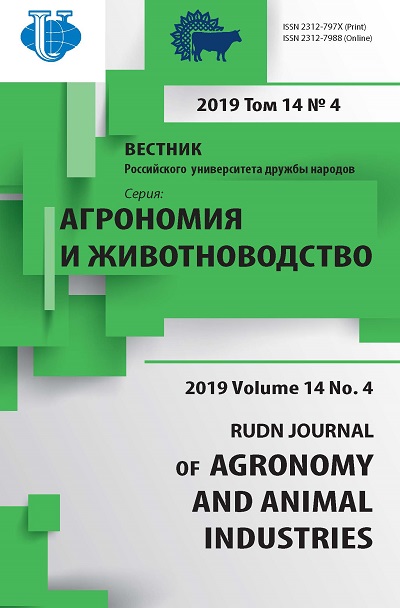Биотехнологические подходы, снижающие биогенные риски в растениеводстве, на примере картофеля
- Авторы: Ленивко С.М.1, Бойко В.И.1
-
Учреждения:
- Брестский государственный университет имени А.С. Пушкина
- Выпуск: Том 14, № 4 (2019)
- Страницы: 403-422
- Раздел: Генетика и селекция растений
- URL: https://agrojournal.rudn.ru/agronomy/article/view/19526
- DOI: https://doi.org/10.22363/2312-797X-2019-14-4-403-422
- ID: 19526
Цитировать
Полный текст
Аннотация
Приведен обзор биогенных агроэкологических рисков в растениеводстве, для снижения которых возможно использование биотехнологических подходов. Рассмотрены пути, предлагаемые современной биотехнологией, для снижения негативного влияния двух наиболее распространенных вредоносных объектов: колорадского жука ( Leptinotarsa decemlineata Say) и фитофторы ( Phytophthora infestans (Mont.) de Bary), приводящих к значительным потерям урожая картофеля. Проведен анализ возможных потенциальных рисков, связанных с использованием трансгенных организмов. Показано, что применяемые в настоящее время методы клеточной инженерии растений (соматическая гибридизация и микроклональное размножение) являются экологически оправданными биотехнологическими способами борьбы с фитофторозом. Потребность разработки генно-инженерных методов связана с обострением биогенных агроэкологических рисков, для снижения которых эффективна стратегия упреждающей интрогрессивной селекции, основанной на клеточноинженерных и молекулярных методах.
Об авторах
Светлана Михайловна Ленивко
Брестский государственный университет имени А.С. Пушкина
Автор, ответственный за переписку.
Email: lenivko@brsu.brest.by
кандидат биологических наук, доцент кафедры зоологии и генетики
Брест, Республика БеларусьВладимир Иванович Бойко
Брестский государственный университет имени А.С. Пушкина
Email: boikobio@yandex.by
кандидат биологических наук, доцент кафедры ботаники и экологии
Брест, Республика БеларусьСписок литературы
- Национальный статистический комитет Республики Беларусь. Режим доступа: http://www.belstat.gov.by/ofitsialnaya-statistika/. Дата обращения: 01.08.2019.
- FAOSTAT // Продовольственная и сельскохозяйственная организация ООН. Режим доступа: http://www.fao.org/faostat/ru/#data/QC Дата обращения: 29.10.2019.
- Хавкин Э.Е. Устойчивость картофеля к фитофторозу глазами молекулярного биотехнолога // Проблемы агробиотехнологии / под ред. П.Н. Харченко. М.: ВНИИСБ, 2012. С. 69—92.
- Дьяков Ю.Т., Еланский С.Н. Популяционная генетика Phytophthora infestans // Микология сегодня / под ред. Ю.Т. Дьякова, Ю.В. Сергеева. М.: Национальная академия микологии, 2007. Т. 1. С. 107—139.
- Чашинский А.В. Использование мексиканских видов S. stoloniferum и S. polytrichon при создании исходного материала, устойчивого к фитофторозу // Картофелеводство: сб. науч. тр. / под ред. С.А. Турко. Минск: Науч.-практ. центр Нац. акад. наук Беларуси по картофелеводству и плодоовощеводству, 2015. Т. 23. С. 56—68.
- Фадина О.А., Бекетова М.П., Соколова Е.А., Кузнецова М.А., Т.И. Сметанина Т.И., Рогозина Е.В., Хавкин Э.Е. Упреждающая селекция: использование молекулярных маркеров при создании доноров устойчивости картофеля (Solanum tuberosum L.) к фитофторозу на основе сложных межвидовых гибридов // Сельскохозяйственная биология. 2017. Т. 52. № 1. С. 84—94. doi: 10.15389/agrobiology.2017.1.84rus
- Яковлева Г.А. Соматическая гибридизация и клеточная селекция картофеля (Solanum tuberosum L.) // Биотехнология в селекции растений. Клеточная инженерия / науч. ред. А.В. Кильчевский, Л.В. Хотылева. Минск: Белорусская наука, 2012. Т. 3. С. 217—250.
- Яковлева Г.А., Семанюк Т.В., Кондратюк А.В., Башко Д.В., Родькина И.А. Селекция генеративного потомства соматических гибридов и создание новых исходных форм картофеля // Картофелеводство: сб. науч. тр. / под ред. С.А. Турко. Минск: Науч.-практ. центр Нац. акад. наук Беларуси по картофелеводству и плодоовощеводству, 2017. Т. 25. С. 94—104.
- Jacobsen E., Schouten H.J. Cisgenesis, a new tool for traditional plant breeding, should be exempted from the regulation on genetically modified organisms in a step by step approach // Potato Research. 2008. Vol. 51. P. 75—88. doi: 10.1007/s11540-008-9097-y
- Янковская Е.Н., Войтка Д.В., Бречко Е.В., Елисовецкая Д.С., Настас Т.Н. Онтогенетические особенности восприимчивости колорадского жука к воздействию биопрепаратов и растительных экстрактов // под ред. С.А. Турко. Минск: Науч.-практ. центр Нац. акад. наук Беларуси по картофелеводству и плодоовощеводству, 2014. Т. 22. С. 78—88.
- Perlak F.J., Stone T.B., Muskopf Y.M., Petersen L.J., Parker G.B., McPherson S.A., Wyman J., Love S., Reed G., Biever D., Fischhoff D.A. Genetically improved potatoes: protection from damage by colorado potato beetles // Plant Molecular Biology. 1993. Vol. 22. No. 2. P. 313— 321. doi: 10.1007/BF00014938
- James C., Krattiger A.F. Global Review of the Field Testing and Commercialization of Transgenic Plants, 1986 to 1995: The First Decade of Crop Biotechnology // ISAAA Briefs No. 1. ISAAA: Ithaca, NY, 1996. 31 p. Available from: http://www.isaaa.org/resources/publications/ briefs/01/download/isaaa-brief-01-1996.pdf
- Global Status of Commercialized Biotech/GM Crops: 2016. ISAAA Brief No. 52. ISAAA: Ithaca, NY, 2016. 135 p. Available from: http://www.isaaa.org/resources/publications/briefs/ 52/download/isaaa-brief-52-2016.pdf
- Мозгова Г.В. Оценка рисков воздействия ГМО на сохранение и устойчивое использование биологического разнообразия, с учетом рисков для здоровья человека. Минск: Право и экономика, 2014. 58 с.
Дополнительные файлы















